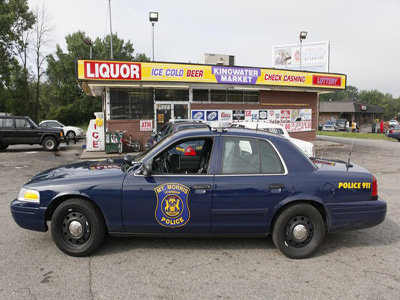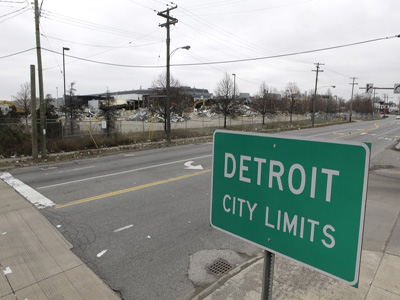A city where murder is nearly a daily occurance stands a good shot of being named the most violent, crime-prone area in the country. And last year there were 345 murders reported in the Detroit metropolitan area - altogether 1,111 violent crimes per 100,000 residents.
To compile our list of America’s most dangerous cities, we used the FBI’s uniform crime report for 2010, which tallies crime data for each of the country’s metropolitan statistical areas, regions that usually consist of a large city and its suburbs or nearby cities. Because small fluctuations in crime numbers can produce outsize jumps in rates in smaller metropolitan areas, we looked at MSAs with a population of 200,000 or more. We used the FBI’s numbers for four categories of violent crimes: murder and non-negligent manslaughter; forcible rape; robbery; and aggravated assault.
It’s commonly expected that crime will rise as economic conditions worsen, but that hasn’t been the case in the U.S. – violent crime has fallen for the past four years. In 2010, murder was down 4%, rape fell 5%, robbery dropped 10%, and aggravated assault fell 4%, according to the FBI. “There’s a complex series of forces at work behind these rates,” says Tom Blomberg, dean of the College of Criminology and Criminal Justice at Florida State Univeristy. “The state of the economy, demographics, the number of young males at any given time, the rate of imprisonment and the number of police all factor in.”
The nationwide drop in crime extends to several of our most dangerous cities, including the Memphis, Tenn., area, which comes in at No. 2 with 1,006 violent crimes per 100,000 residents, down from 1,146 the year before. “Many of [the bottom-most cities] are actually improving, it’s just that so are other cities at a higher rate,” says Wolfram, an intelligence analyst at iJET.
Chronic poverty likely plays a role in Memphis’ high crime rate – 19.1% of the residents of the metropolitan area were below the poverty line in 2010, making it the most impoverished large metro area in the country, according to Census Bureau data. But detailed record keeping also plays a part in why Memphis ranks so highly on our list: the city’s police department adopted a data-driven approach to policing in 2006 that relies on exhaustive and meticulous incident tracking. As a result, it may be recording crimes that in other cities would go unreported to the FBI.
The Springfield, Ill., metropolitan area ranks third on our list with 855 violent crimes per 100,000 residents in 2010. The Illinois state capital confounds analysts who try to interpret its relatively high crime rate. The unemployment rate was lower than the national average at 7% as of July so the economy wouldn’t seem to play a major role in crime. The area’s relatively young population – 66% of the city is under the age of 44 – may be a factor, as younger areas generally have higher rates of crime.
Despite a foundering economy and a stubborn unemployment rate, crime in the United States continues the general downward trend that began in the 1990s. Is it because incarceration rates remain high? Because it takes time for crime trends to change? Or because there are more police on the streets using more sophisticated, data-driven methods? Experts can’t say, but the trend extends even to Detroit, which saw a decrease in murders from 398 in 2009 to 345 in 2010.
Here are America's five most dangerous cities, according to government statistics:
 |
With 813 violent crimes per 100,000 residents, Anchorage has a somewhat higher crime rate than cities of comparable size, and a rate that is double the size of Alaska as a whole. It is the largest city in the state, but it also has the largest rate of forcible rape, which contributes to Anchorage’s high crime statistics. Property crime, while not factored into our survey, is also double Alaska’s rate. Methamphetamine use has been a perennial problem in Anchorage and elsewhere in the state, and although laws have been passed to limit access to the pharmaceuticals necessary to manufacture meth in the state, a steady supply of the drug is still flowing in from Mexico.
Flint, MI no.4
 |
With 827 violent crimes per 100,000 residents, Flint is an example of a city where a lousy local economy and a high unemployment rate have fueled crime. The area has lost thousands of auto manufacturing jobs, and as with Detroit, there’s been a drop in population. “People don’t have jobs, they don’t have money for food, so they become a lot more desperate, and these trends take a long time to reverse,” says Megan Wolfram, an intelligence analyst at the risk assessment firm iJET.
 |
The capital city of Illinois, Springfield ranks third on our list because it had 855 violent crimes per 100,000 residents in 2010. The city also confounds analysts who try to interpret its relatively high crime rate. The unemployment rate was lower than the national average at 7% as of July, so the economy wouldn’t seem to play a major role in crime. And although meth usage saw a small spike in the mid-2000s, a law passed a few years ago making the necessary pharmaceutical ingredients harder to buy seems to have cut down on abuse. There are also poorer neighborhoods – literally on the other side of the railroad tracks – that tend to have higher rates of poverty and the higher rates of crime that accompany that, which contributes to the city’s overall higher rate of crime. Another factor could be Springfield’s relatively young population – 66% of the city is under the age of 44 – and relatively younger populations are historically correlated with higher rates of crime.
Memphis, TN no.2
 |
The Memphis metropolitan area logged 1,006 violent crimes per 100,000 residents last year, down from 1,146 in 2009. Chronic poverty likely plays a role – 19.1% of the residents of the were below the poverty line in 2010, making it the most impoverished large metro area in the country, according to Census Bureau data. But detailed record keeping also plays a part in why Memphis ranks so highly on our list: the city's police department adopted a data-driven approach to policing in 2006 called Blue Crush that relies on accurate incident tracking, for which it adopted the FBI’s meticulous crime reporting method known as the National Incident-Based Reporting System. As a result, it may be recording crimes that in other cities would go unreported to the FBI. Though the crime rate remains comparatively high, the Memphis Police Department says that serious crime has dropped more than 25% since it began the Blue Crush program in 2006.
Detroit-Livonia-Dearborn, MI Metropolitan District no.1
 |
Detroit consistently ranks as one of America’s most crime-ridden cities, and it comes in first on our list for 2010 with 1,111 violent crimes per 100,000 residents. A precipitous drop in population and employment rates due to suburbanization and the struggles of the Big Three automakers is a big factor, leaving the city strapped of funds to devote to basic services like education and public safety. “Year in, year out, and decade after decade, there’s been a very large population loss,” says Brian Stults, an assistant professor of criminology at Florida State University. “A large section of the population is gone, and they’re not the people doing crime to begin with.”
No comments:
Post a Comment